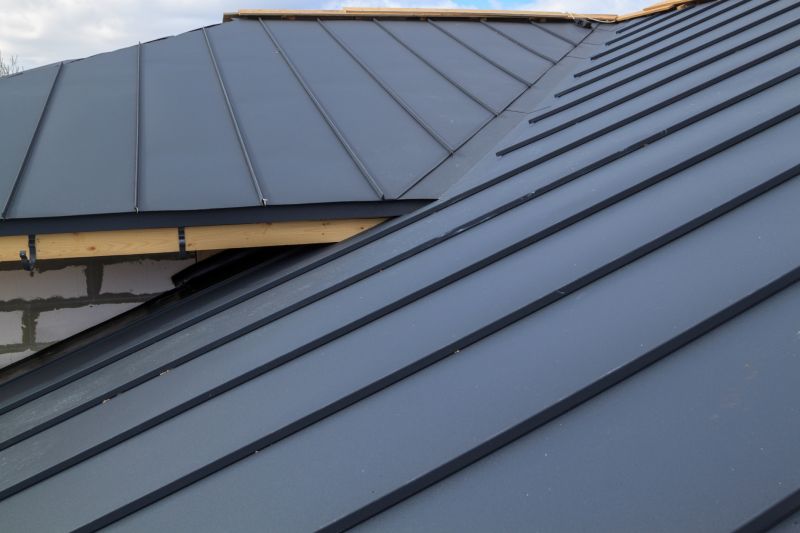Top Choices For Professionals Installing Standing Seam Metal Roofs
Browse the preferred products trusted by experienced contractors for durable and precise metal roof installations.
 Standing seam metal roofs are a popular choice for many building projects due to their durability and sleek appearance. Installing such roofs requires specialized products that ensure proper sealing, fastening, and long-term performance. The selection of appropriate installation products can influence the ease of installation and the longevity of the roof system. From seam clamps to sealing tapes, a variety of tools and materials are available to facilitate a secure and weather-tight installation.
Standing seam metal roofs are a popular choice for many building projects due to their durability and sleek appearance. Installing such roofs requires specialized products that ensure proper sealing, fastening, and long-term performance. The selection of appropriate installation products can influence the ease of installation and the longevity of the roof system. From seam clamps to sealing tapes, a variety of tools and materials are available to facilitate a secure and weather-tight installation.
Top Overall Option
Universal Standing Seam Roof Fastening System
This versatile fastening system is designed to accommodate various standing seam profiles and materials. It offers adjustable clamps and corrosion-resistant components, making it suitable for a wide range of installation scenarios. Its user-friendly design helps facilitate secure attachment while allowing for thermal movement, contributing to a reliable and lasting roof assembly.
Types of Products For Standing Seam Metal Roof Installations
Seam Clamps
Clamps designed to hold and secure the seams during installation, available in various sizes for different seam widths.
Snap Lock Clips
Mechanical clips that allow for quick attachment and facilitate thermal movement, ideal for snap lock seams.
Screws and Fasteners
Corrosion-resistant screws specifically designed for metal roofing, used to secure panels and seam components.
Sealant Tapes
Specialized tapes used to seal seams and prevent water ingress, ensuring weather-tightness.
Sealants and Caulks
High-quality sealants formulated for metal surfaces, used to fill gaps and enhance waterproofing.
Edge and Closure Strips
Materials used to seal edges and closures for a finished look and added protection against elements.
Rivets and Fastening Pins
Alternative fastening options for securing panels and components, especially in retrofit applications.
Underlayment Sheets
Protective layers installed beneath the metal panels to provide additional moisture barrier and insulation.
Corner and Ridge Cap Components
Specialized pieces designed to finish the roof edges and ridges, providing a clean and weather-resistant seal.
Installation Hand Tools
Tools such as seam rollers, snips, and screwdrivers tailored for metal roofing installation tasks.
Thermal Expansion Joints
Components that accommodate movement caused by temperature changes, reducing stress on the roof system.
Gutter and Drainage Attachments
Products used to securely attach gutters and drainage systems to the roof edges.
Insulation and Vapor Barriers
Materials installed beneath the roof to improve energy efficiency and prevent moisture issues.
Popular Choices
Widely used clips that facilitate quick and secure seam fastening, compatible with various seam types.
Fasteners featuring rubber washers for enhanced weather resistance and secure attachment.
Popular sealing tape for seams and penetrations, providing a flexible and durable seal.
Commonly used for quick installation, these clips help accommodate thermal movement.
Versatile sealants suitable for sealing joints and fastener penetrations on metal roofs.
Essential for sealing edges and preventing debris infiltration, available in various profiles.
Alternative fastening method for panels and accessories, often used in retrofit projects.
Commonly selected for additional moisture protection beneath metal panels.
Preformed pieces for finishing the roof ridges, ensuring weather resistance.
Essential tools like seam rollers and snips for efficient installation and adjustments.
Components that allow for thermal movement, reducing stress on the roof system.
Products designed to securely attach gutters to the roof edges, ensuring proper drainage.
Used with sealants to fill large gaps and joints, enhancing waterproofing.
Understanding the different types of installation products is essential for contractors and DIY enthusiasts alike. These products are designed to accommodate the specific demands of standing seam metal roofing, including flexibility for thermal expansion and contraction, resistance to corrosion, and ease of use during installation. Properly chosen products can help achieve a professional finish and maintain the integrity of the roof over time.
The market offers a wide array of options, from mechanical fasteners to specialized sealants, each serving a unique purpose in the installation process. Selecting the right combination of products depends on factors such as the roof's design, material, and the environmental conditions of the installation site. Informed decisions can lead to more efficient installation workflows and better long-term performance.
Whether you are a seasoned roofer or a homeowner undertaking a renovation, understanding the available products for standing seam metal roof installations can help you make confident choices. Carefully considering product specifications, compatibility, and quality will ensure that your roofing project meets desired standards and provides reliable service for years to come.
Key Buying Considerations
- Compatibility with your specific seam profile and material type.
- Corrosion resistance, especially in areas prone to moisture or salt exposure.
- Ease of installation and whether the product is suitable for DIY or professional use.
- Flexibility to accommodate thermal expansion and contraction of metal panels.
- Weatherproofing capabilities, including sealing and waterproofing features.
- Durability and longevity based on material quality and coating.
- Availability of replacement parts or accessories for future repairs.
- Compatibility with other roofing components such as underlayment and ridge caps.
- Ease of handling and installation tools required for the product.
- Cost-effectiveness relative to the overall project budget.
- Manufacturer reputation and product reviews for reliability.
- Warranty or guarantee offered by the supplier.
- Environmental conditions typical of your installation site.
- Compliance with local building codes and standards.
- Availability of technical support or installation guidance.
